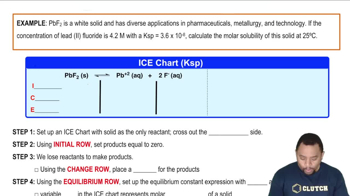Write balanced equations and expressions for Ksp for the dissolution of each ionic compound. c. Ag2CrO4
Ch.17 - Aqueous Ionic Equilibrium
Chapter 17, Problem 87b,c
Refer to the Ksp values in Table 17.2 to calculate the molar solubility of each compound in pure water. b. Mg(OH)2 c. CaF2
 Verified step by step guidance
Verified step by step guidance1
Identify the dissolution reaction for each compound. For Mg(OH)_2, the reaction is: Mg(OH)_2 (s) \rightleftharpoons Mg^{2+} (aq) + 2OH^- (aq). For CaF_2, the reaction is: CaF_2 (s) \rightleftharpoons Ca^{2+} (aq) + 2F^- (aq).
Write the expression for the solubility product constant (K_{sp}) for each compound. For Mg(OH)_2, K_{sp} = [Mg^{2+}][OH^-]^2. For CaF_2, K_{sp} = [Ca^{2+}][F^-]^2.
Let the molar solubility of Mg(OH)_2 be 's'. Then, [Mg^{2+}] = s and [OH^-] = 2s. Substitute these into the K_{sp} expression for Mg(OH)_2: K_{sp} = s(2s)^2.
Let the molar solubility of CaF_2 be 's'. Then, [Ca^{2+}] = s and [F^-] = 2s. Substitute these into the K_{sp} expression for CaF_2: K_{sp} = s(2s)^2.
Solve the equations for 's' using the given K_{sp} values from Table 17.2 to find the molar solubility of each compound.

Verified video answer for a similar problem:
This video solution was recommended by our tutors as helpful for the problem above.
Video duration:
2mWas this helpful?
Key Concepts
Here are the essential concepts you must grasp in order to answer the question correctly.
Solubility Product Constant (Ksp)
The solubility product constant (Ksp) is an equilibrium constant that applies to the solubility of sparingly soluble ionic compounds. It represents the maximum concentration of ions that can exist in a saturated solution at a given temperature. For a compound like Mg(OH)2, Ksp is calculated from the concentrations of its dissociated ions, allowing for the determination of its molar solubility in water.
Recommended video:
Guided course

Solubility Product Constant
Dissociation of Ionic Compounds
Ionic compounds dissociate into their constituent ions when dissolved in water. For example, CaF2 dissociates into one calcium ion (Ca²⁺) and two fluoride ions (F⁻). Understanding the stoichiometry of this dissociation is crucial for calculating molar solubility, as it directly influences the concentrations of the ions involved in the Ksp expression.
Recommended video:
Guided course

Ionic Compounds Naming
Molar Solubility
Molar solubility is defined as the number of moles of a solute that can dissolve in one liter of solution at equilibrium. It is derived from the Ksp expression and reflects how much of a compound can dissolve in water. By setting up the Ksp expression based on the dissociation of the compound, one can solve for the molar solubility, which is essential for understanding the compound's behavior in aqueous solutions.
Recommended video:
Guided course

Molar Solubility Example
Related Practice
Textbook Question
Textbook Question
Write balanced equations and expressions for Ksp for the dissolution of each ionic compound. a. CaCO3 b. PbCl2 c. AgI
Textbook Question
Refer to the Ksp values in Table 17.2 to calculate the molar solubility of each compound in pure water. a. AgBr
Textbook Question
Refer to the Ksp values in Table 17.2 to calculate the molar solubility of each compound in pure water. a. MX (Ksp = 1.27⨉10-36) b. Ag2CrO4 c. Ca(OH)2
Textbook Question
Use the given molar solubilities in pure water to calculate Ksp for each compound. a. MX; molar solubility = 3.27⨉10-11 M
Textbook Question
Use the given molar solubilities in pure water to calculate Ksp for each compound. b. PbF2; molar solubility = 5.63⨉10-3 M c. MgF2; molar solubility = 2.65⨉10-4 M
